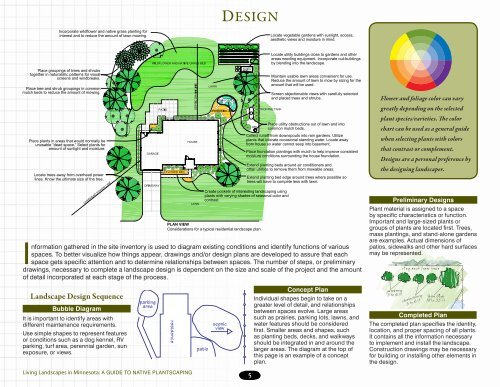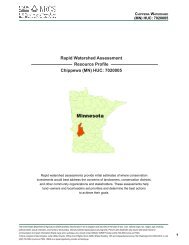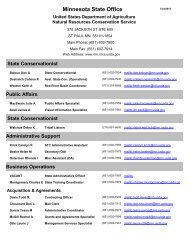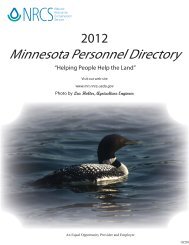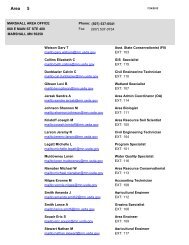Living Landscapes in Minnesota: - Minnesota NRCS - US ...
Living Landscapes in Minnesota: - Minnesota NRCS - US ...
Living Landscapes in Minnesota: - Minnesota NRCS - US ...
Create successful ePaper yourself
Turn your PDF publications into a flip-book with our unique Google optimized e-Paper software.
DESIGN<br />
Information gathered <strong>in</strong> the site <strong>in</strong>ventory is used to diagram exist<strong>in</strong>g conditions and identify functions of various<br />
spaces. To better visualize how th<strong>in</strong>gs appear, draw<strong>in</strong>gs and/or design plans are developed to assure that each<br />
space gets specific attention and to determ<strong>in</strong>e relationships between spaces. The number of steps, or prelim<strong>in</strong>ary<br />
draw<strong>in</strong>gs, necessary to complete a landscape design is dependent on the size and scale of the project and the amount<br />
of detail <strong>in</strong>corporated at each stage of the process.<br />
Landscape Design Sequence<br />
Bubble Diagram<br />
It is important to identify areas with<br />
different ma<strong>in</strong>tenance requirements.<br />
Use simple shapes to represent features<br />
or conditions such as a dog kennel, RV<br />
park<strong>in</strong>g, turf area, perennial garden, sun<br />
exposure, or views.<br />
park<strong>in</strong>g<br />
area<br />
residence<br />
<strong>Liv<strong>in</strong>g</strong> <strong>Landscapes</strong> <strong>in</strong> M<strong>in</strong>nesota: A GUIDE TO NATIVE PLANTSCAPING<br />
patio<br />
scenic<br />
view<br />
5<br />
Concept Plan<br />
Individual shapes beg<strong>in</strong> to take on a<br />
greater level of detail, and relationships<br />
between spaces evolve. Large areas<br />
such as prairies, park<strong>in</strong>g lots, lawns, and<br />
water features should be considered<br />
first. Smaller areas and shapes, such<br />
as plant<strong>in</strong>g beds, decks, and walkways<br />
should be <strong>in</strong>tegrated <strong>in</strong> and around the<br />
larger areas. The diagram at the top of<br />
this page is an example of a concept<br />
plan.<br />
Flower and foliage color can vary<br />
greatly depend<strong>in</strong>g on the selected<br />
plant species/varieties. Th e color<br />
chart can be used as a general guide<br />
when select<strong>in</strong>g plants with colors<br />
that contrast or complement.<br />
Designs are a personal preference by<br />
the design<strong>in</strong>g landscaper.<br />
Prelim<strong>in</strong>ary Designs<br />
Plant material is assigned to a space<br />
by specific characteristics or function.<br />
Important and large-sized plants or<br />
groups of plants are located first. Trees,<br />
mass plant<strong>in</strong>gs, and stand-alone gardens<br />
are examples. Actual dimensions of<br />
patios, sidewalks and other hard surfaces<br />
may be represented.<br />
Completed Plan<br />
The completed plan specifies the identity,<br />
location, and proper spac<strong>in</strong>g of all plants.<br />
It conta<strong>in</strong>s all the <strong>in</strong>formation necessary<br />
to implement and <strong>in</strong>stall the landscape.<br />
Construction draw<strong>in</strong>gs may be necessary<br />
for build<strong>in</strong>g or <strong>in</strong>stall<strong>in</strong>g other elements <strong>in</strong><br />
the design.


